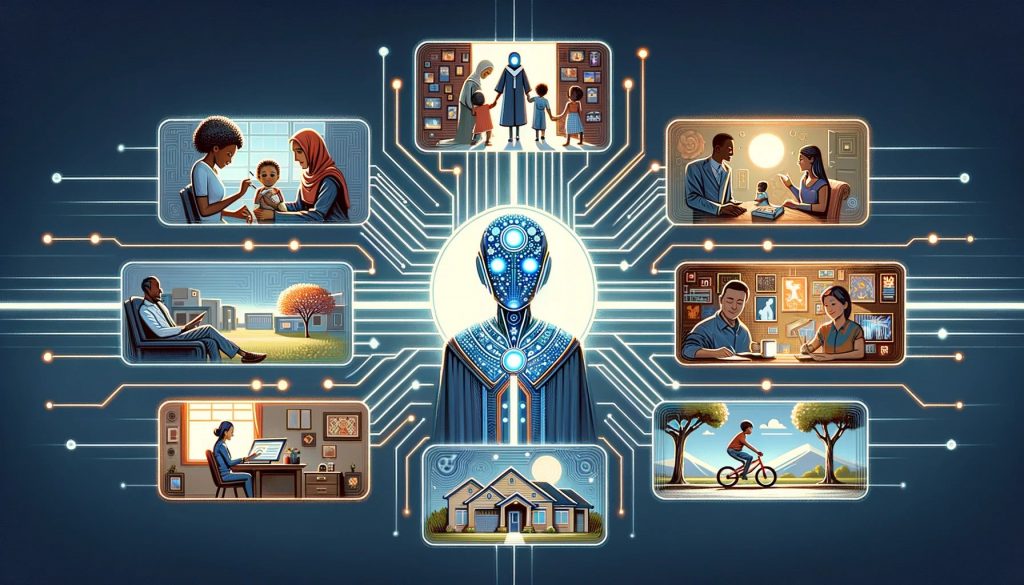Picture a scenario where you’ve just been involved in a minor car mishap on your way home. The usual protocol would involve a lengthy wait for an insurance adjuster’s inspection and assessment.
However, in this AI-driven scenario, you simply whip out your smartphone, capture some images of the dented bumper, and upload them onto your insurance provider’s app, along with a brief account of the incident.
Within a span of mere minutes, an AI-powered claims processor reviews the images, cross-references your policy details, and notifies you with an approved repair claim amount. No long waits, no tiresome back-and-forths.

This scenario isn’t a page from a science fiction novel, but a glimpse into the foreseeable future of insurance, thanks to the strides in Generative AI. With the recent advancements in deep learning and neural networks, AI systems have ascended to a level where they can synthesize and analyze data with a blend of accuracy and complexity that mirrors human cognition. Unlike the earlier AI models in insurance that were confined to executing simple, rules-based tasks, contemporary generative models are inching closer to replicating the nuanced decision-making and subjective evaluations essential for processes like claims assessments.
The Journey of AI in Insurance: From Automation to Generation

The narrative of AI in insurance is not new; it has been gradually unfolding over the past few decades. The 1960s and 70s marked the advent of expert systems—software that encapsulated complex human knowledge in the form of decision rules and logic flows. These systems found fertile ground in the insurance domain, aiding in risk assessment and underwriting based on pre-programmed rules. However, their Achilles’ heel was the lack of flexibility and adaptability to novel data, thereby restricting their application to a predefined set of scenarios.
Fast forward to the 1980s, statistical machine-learning techniques emerged, offering a sliver of hope. By scrutinizing historical data, algorithms like regression, random forests, and support vector machines could learn to make pricing and risk predictions based on patterns and correlations. This era saw insurers eagerly harnessing machine learning for actuarial analytics, claims projections, and anti-fraud efforts. Yet, the core limitation remained—the models were tethered to the specific relationships and distributions hardcoded into their design, unable to conduct end-to-end automated underwriting.
The transformative pivot arrived in the 2010s, with a confluence of burgeoning datasets, burgeoning computing power, and the maturation of neural network techniques. This fertile confluence bore the fruit of Generative AI, embodied by models like Generative Adversarial Networks (GANs), Variational Autoencoders (VAEs), and Diffusion models. These models could not only analyze but also construct new data points, moving beyond rigid statistical relationships to learning rich representations crucial for replicating the multifaceted workflows in insurance.
Demystifying Generative AI

Generative AI, at its core, is like a prolific artist, capable of creating realistic, novel content across various mediums—text, images, audio, and video. The powerhouse behind this capability is deep neural networks—complex matrices of mathematical functions somewhat inspired by the human brain’s architecture. Here, let’s unpack some pivotal terms and models within the generative AI domain:
Key Models in Generative AI
- Generative Adversarial Networks (GANs): GANs are like a meticulous craftsman paired with a discerning critic. They consist of two neural networks—the generator, striving to create realistic synthetic data, and the discriminator, endeavoring to distinguish the fabricated data from real data. Through this adversarial tussle, both networks hone their abilities, leading to the generation of highly realistic data.
- Diffusion Models: Imagine an artist starting with a blank canvas, where each stroke gradually morphs the blank space into a coherent image. Diffusion models adopt a similar approach—they commence with random noise and progressively refine it into coherent data through iterative alterations.
- Transformers: As the new stalwarts in the generative AI arena, transformers process data in parallel, capturing context and long-range dependencies within data sequences. They have significantly advanced the field of natural language processing, contributing to more sophisticated natural language generation and understanding.
Tailoring Generative AI to Insurance
Now, the intriguing question—how does feeding a plethora of actuarial data into these generative models impact the insurance domain? While the raw generative prowess of these models is undeniable, harnessing their potential necessitates a meticulous process of training on specific business data. It’s like possessing a sophisticated calculator yet requiring adept humans to input the right formulas to extract valuable insights.
As we transition from the abstract realm of algorithms and neural networks into the pragmatic landscape of insurance operations, the essence of Generative AI’s impact begins to unfold. By training these models on industry-specific data, insurers can unlock a treasure trove of possibilities—accelerated underwriting, streamlined claims processing, and bolstered fraud detection, to name a few. Now, let’s delve deeper into these applications, illuminating how Generative AI is poised to redefine the insurance landscape.
Unveiling the Potential: Applications of Generative AI in Insurance

Generative AI holds the promise to be a game-changer across various facets of the insurance ecosystem, from underwriting and claims processing to fraud detection and customer engagement.
Streamlining Underwriting and Policy Administration
Generative AI models, bolstered by Natural Language Processing (NLP) and Computer Vision, can automate the extraction of relevant information from insurance applications, medical reports, and financial statements, significantly reducing manual effort. For instance, computer vision algorithms can scrutinize scanned documents or satellite imagery to assess property damage, construction quality, and proximity to hazards, automating risk analysis to a large extent.
Accelerating Claims Assessment and Processing
The realm of claims assessment is ripe for AI-driven transformation. Computer vision can analyze images of damaged assets, while NLP extracts pertinent details from claims submissions, police reports, and medical documents, providing a holistic view of claims assessment. Furthermore, Generative Adversarial Networks (GANs) can synthesize additional simulated claims data, aiding in training machine learning models, especially when real samples are sparse.
Enhancing Fraud Detection and Prevention

Anomaly detection techniques coupled with graph analysis can unveil unusual claims patterns and suspicious relationships, warranting further investigation. Chatbots powered by advanced NLP can gather additional information from claimants, enabling swift verification of potential fraud before large payouts.
Streamlining Pension Risk Transfer
Pension risk transfer (PRT) is a complex dance of actuarial analysis and underwriting, often involving the transition of a company’s defined benefit pension obligations to an insurer through annuity buyout or buy-in arrangements. Generative models can hasten this intricate process by simulating population mortality rates, longevity trends, and other actuarial assumptions. By doing so, they enable more accurate pricing of pension liabilities and de-risking of pension plans through annuities. Leading reinsurers and insurers are already investing in AI to enhance pension risk transfers, signifying a positive trajectory towards modernized PRT processes.
Revolutionizing Marketing and Customer Communication
The advent of Natural Language Generation (NLG) algorithms has opened doors to personalized policy documents and reports tailored to individual customer circumstances and behaviors. Unlike static, generic templates, NLG can dynamically synthesize personalized narratives, enhancing customer comprehension and engagement. For instance, integrating varied data sources like a farmer’s crop yield patterns, soil quality, and local weather models can result in a customized report elucidating how potential droughts may impact their premiums. The ripple effect of such personalized communication is profound, fostering better-informed customers and nurturing a stronger insurer-customer bond.
Innovating New Insurance Products

The infusion of Internet of Things (IoT) devices and predictive analytics has birthed novel insurance products like usage-based insurance, where premiums are priced based on real-time behavior. Platforms utilizing generative models can provide parametric insurance with automatic payouts based on external data triggers, blending real-time data with predictive insights for a more responsive insurance paradigm.
Enhanced Actuarial Modeling:
Generative models extend a lifeline to actuaries grappling with limited data samples. By synthesizing additional customer data, these models can improve predictive accuracy. They also enable the creation of thousands of hypothetical economic scenarios to stress-test financial models, offering a robust framework for more informed decision-making in uncertain economic landscapes.
Navigating the Challenges: Responsible Implementation of Generative AI
While the horizon is brimming with promise, the voyage toward AI-powered insurance is laden with challenges that demand a conscientious approach.
Ensuring Transparency and Explainability

The opacity of ‘black-box’ models can culminate in harmful outcomes that flout ethics and compliance standards. Techniques like LIME (Local Interpretable Model-agnostic Explanations) and Shapley values are pivotal in demystifying AI model decisions, especially in high-stakes realms like underwriting, pricing, and claims assessment.
Avoiding Unintended Bias
The specter of bias looms large, as real-world data, algorithms, and human judgment entwined in AI development can inadvertently perpetuate existing biases. Rigorous bias testing throughout development and post-deployment monitoring are critical to mitigate this threat.
Upholding Data Privacy and Responsible Data Practices
As insurance executives grapple with the privacy quandaries emanating from AI, establishing a robust data governance framework is indispensable. This includes rigorous consent procedures, anonymization techniques, and stringent access controls for customer data used in generative models.
The Road Ahead: Opportunities and Imperatives

As the tendrils of Generative AI intertwine with the fabric of the insurance sector, a horizon of transformative prospects emerges:
Hyper-Personalized Products and Pricing
In a world inundated with data, the opportunity to tailor insurance products to individual behavioral profiles is tantalizing. By harnessing vast data streams from IoT devices and APIs, insurers can offer coverage that morphs in real-time with evolving risk factors. However, this promise of affordability and personalization must be balanced with privacy concerns and consent for continuous data extraction.
Frictionless Customer Experiences
Imagine a claims processing journey that concludes within minutes, not weeks. By auto-assessing damage, determining approvals, and disbursing payments swiftly, Generative AI can significantly reduce friction in customer interactions. However, retaining human involvement at critical junctures is crucial to maintaining a touch of empathy and trust.
Transformed Marketing and Customer Engagement
The ability to craft marketing content that resonates with each individual opens doors to enhanced customer engagement. Yet, it also raises ethical eyebrows around predatory micro-targeting. Safeguards like ethics reviews, explicit consent for data usage, and monitoring consumer persuasion metrics are essential to foster trust while reaping the benefits of personalized marketing.
Proactive Regulatory Collaboration:
Pioneering insurers have a compelling incentive to engage proactively with regulators to develop governance frameworks that balance innovation with ethical and social considerations. Collaborative rule-making and structured exchanges during development sprints can align priorities and ensure a responsible approach toward leveraging Generative AI.
Conclusion
Generative AI, when wielded judiciously, holds the potential to unlock a new paradigm in insurance—one characterized by enhanced personalization, accessibility, and affordability. However, steering this disruptive transformation towards a positive horizon necessitates a concerted effort.
It’s about centering ethics, human judgment, and transparency while re-skilling workforces and refining governance frameworks. With a blend of pragmatic optimism and collective responsibility, the journey towards AI-enabled insurance could indeed be a harbinger of broader financial inclusion and a more customer-centric insurance ethos.



